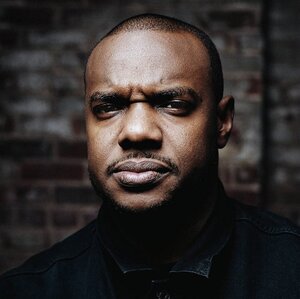Rashid Shabazz, Executive Director, Critical Minded
July 29, 2021
Rashid Shabazz is the inaugural executive director of Critical Minded, a grantmaking and advocacy initiative founded in 2017 by the Ford and Nathan Cummings foundations to support cultural critics of color in the United States by building a cultural ecosystem celebrating the multiplicity of perspectives from critics of color.
Shabazz joined Critical Minded following his role as the chief marketing and storytelling officer for Color of Change, where he developed initiatives such as the #ChangeMusic and #ChangeHollywood campaigns to push for accountability within the media to more accurately portray Black narratives. During his time there, he also helped release several reports, including Normalizing Injustice, a comprehensive study of the inaccurate portrayals of the criminal justice system in crime procedural shows, and the exclusion of writers of color in writers' rooms.
Before joining Color of Change, Shabazz served as vice president of communications for Campaign for Black Male Achievement (CBMA) — originally an Open Society Foundations initiative — where he created programs that directly challenged false narratives about Black men and boys and expanded access to resources and financial support.
PND asked Shabazz about how philanthropy could more systematically address social inequities in arts funding practices, the steps museums and galleries should take to advance equity, and how Critical Minded is working to narrow gaps found in the underrepresentation of cultural critics of color in art spaces.
Philanthropy News Digest: Despite the efforts of several leading foundations, arts organizations of color and those serving low-income communities in both urban and rural communities face distinct challenges in securing equitable funding. In what ways can philanthropy more systematically address social inequities in its arts funding practices?
Rashid Shabazz: Philanthropy must have its own racial reckoning. It must acknowledge its role in fostering disparities and reinforcing the systems that we are working to dismantle. Foundations generally are not accountable to anyone outside of their donors and boards, so how do we ensure communities of color become part of the decision-making processes? In the past decade, there has been a movement to see grantees as partners and collaborators who specifically address the racial disparities in how funding reaches organizations led by people of color. Yet we know that the funding remains embarrassingly minuscule. So, it means philanthropy must take more risks and be more disruptive. It must be "decolonized," as Edgar Villanueva says. This means shifting the measures and requirements so that more racial equity can be achieved by allowing resources to flow not only to the largest, most sophisticated, and strongest organizations with existing infrastructure but also making big bets on communities of color and shifting wealth so the infrastructure can be created for BIPOC-led organizations to also thrive.
PND: How does the lack of diversity among decision-makers (i.e., arts foundation staff and boards, individual donors, and cultural institution leadership) impact the arts funding landscape?
RS: Research shows us that those in power need diverse relationships and perspectives for funding to reach diverse individuals and organizations fully. For example, since [Ford Foundation president] Darren Walker, [Andrew W. Mellon Foundation president] Elizabeth Alexander, and formerly [Open Society Foundations president] Patrick Gaspard have been foundation presidents, the funding landscape has significantly shifted. This is also true at the foundation staff level. Intentionality is important. Diverse decision-makers create diverse grantmaking and support for diverse programming. Darren Walker's insistence on the need for Black curators in U.S. museums has shifted the landscape over the past six years, and the racial justice reckoning has accelerated that work. However, for diverse leaders and curators to be successful, the institutions themselves must work on decolonizing conceptually and literally and diversifying among all levels of leadership and decision making.
PND: Directors at the Metropolitan Museum of Art in New York and the National Gallery of Art in Washington, D.C., have admitted to a disparity in the representation of Black art. Besides working to diversify collections and making key acquisitions to include Black art, are there other steps museums and galleries should take to advance equity?
RS: Hire Black leaders and curators. Diversify boards. Create acquisitions committees for diverse works. Diversify hiring in institutions so that their entire jobs will not be consumed by diversity and inclusion work but rather by their expertise in art. Look at what Sandra Jackson-Dumont has done upon arriving at the Lucas Museum of Narrative Art. Museums and galleries must empower their curators of color and trust and support them unconditionally. In my observation, the obstacles are rooted in relationships, power, money, and whether you have access to these three things. How do you make spaces accessible that have traditionally felt inaccessible and out of reach to communities of color, especially when the art reflects those communities? So, there must be not just diversification of collections but of the boards and staff in key positions — there must be an investment in the ecosystem of those who will interpret, analyze, and make meaning of the art. There must be investments in art education in schools and communities beyond those resourced and funded by wealthier parents and districts. The arts must be seen as a public trust that is accessible to all, and museums and galleries can then become the voices and advocates for this kind of systemic transformation.
PND: What do you believe are the root causes behind the underrepresentation of cultural critics of color in art spaces? How is Critical Minded working to narrow those gaps, and what impact do you think the arts and art criticism will have on the growing movement surrounding advancing racial justice and equity?
RS: For too long, cultural institutions, from magazine and book publishing to music, film, and visual art, have all been led primarily by white men. The root cause of this is a history of white supremacy and racism that has limited the broader cultural lens beyond a white male gaze. There is frankly no objectivity of opinion but instead outdated white male bias in relation to works being created by a diverse community of BIPOC artists. A recent USC Annenberg study found that just 11 percent of top film critics are people of color, 22 percent being women. The lack of diversity in critical discourse is a constraint that impacts us all. Even as artists of color are increasingly celebrated in the mainstream, the critical establishment is ill-equipped to engage with their work meaningfully. There is also an economic deterrent where criticism generally (as with journalism) does not provide sustainable wages for critics and artists of color.
Culture — in all its forms — is a powerful engine for shaping social norms and narratives that build or dismantle structures that create or prevent equality, opportunity, and dignity, from policy to individual behavior.
Culture — in all its forms — is a powerful engine for shaping social norms and narratives that build or dismantle structures that create or prevent equality, opportunity, and dignity, from policy to individual behavior. To allow artists to shift dominant narratives and seed visions of new possibilities, the ideas embedded in their work must travel and influence public discourse; this is the work of the critic — to analyze and interpret art for the public — to ignite informed discourse around culture and politics. Critical thinking and analysis are essential to an open, robust democracy as well as to the arts. Critical Minded aims to create the conditions needed — namely, room and resources — for critics of color to continue their crucial work. Still, we can't do this alone, so our hope is that philanthropy begins to see, as we do, the value of investing in cultural criticism and critics of color to achieve our shared goals of racial justice and equity.
PND: How has your previous work engaging in storytelling and narrative building with Campaign for Black Male Achievement and Color Of Change prepared you for this new role with Critical Minded that supports critics who work to interpret narratives and encourage unseen stories that advance justice? And what role do you envision media portrayals of Black men and boys playing in positive narrative change?
RS: Culture, communications, and storytelling have been the underlying thread in all I have done as a philanthropic leader while at the Open Society Foundations and the Campaign for Black Male Achievement and in my role at Color Of Change as their inaugural chief marketing and storytelling officer. I strongly believe that culture precedes politics. That decision-makers in positions of power often are informed and educated through the media they consume, which inform the policies and practices that impact us. Too often, the media paints communities of color in simplistic and racist representations that lead to racist and discriminatory policies. My work is always rooted in understanding culture's impact on the policies and practices that shape our lives, linking directly to my new role with Critical Minded.
Humanizing the experience of Black people and communities of color begins first with empowering storytellers, writers, and critics from the community and ensuring they are free to shape the narratives that are authentic to their voice and vision. Positive narrative change requires first narrative power, the infrastructure, and tools to dictate what stories get told about our community over a sustained period. Criticism helps us find intersections with the cultural world — to mainstream media, academia, and many other spaces of discourse. However, critics of color have not been included to the same degree. And critics of color are essential to advancing broader narrative and cultural shifts. But without intentional investment, criticism often defaults to traditional white voices. Critical Minded's task is, as our co-founder Chi-hui Yang states, "[a]t a time when culture has such profound influence in shaping belief systems, public sentiment and policy, it is vital that we have a breadth of minds from non-dominant perspectives decoding, lifting up and holding to account the narratives embedded in cinema, visual art, TikTok videos and other cultural forms that we consume daily."
— Lauren Brathwaite





